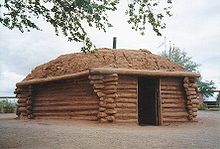Hogan
The Hogan ( Navajo hooghan , [hoːɣan] ; German "home", "home") is the traditional home of the Diné .
construction
The original shape was a dome-shaped rotunda. The scaffolding was made up of tree trunks set upright in the ground, which were covered with clay or earth. Mostly the wood of the Pinyon pine ( Pinus edulis ) was used, a pine species of the semi-deserts that can grow up to 10 m high. Traditional Hogans had no windows on the sides, but only one or two very small skylights, which were actually only used for ventilation and smoke extraction. The fireplace was in the middle of the hogan.
Today the Hogans are mostly hexagonal or octagonal and have a diameter of around 8 meters. The entrance always faces east so that the residents can greet the rising sun and the new day. Traditionally, they are still built from tree trunks that cross at the corners. The joints in the side walls are filled with clay, and the roof is covered with a thick layer of earth. Stone and cement are now also used as building materials, but the basic shape and orientation towards the cardinal points are always retained. In the past, wealthy families could have several, smaller hogans.
use
In the eyes of the Diné and Navajo , Hogans are not just homes and family meeting places. They should also offer space for ceremonial events and they are considered a “holy place” to which the highest gods are quasi “invited” to “live” there. If someone died naturally in his hogan, his hogan is now also considered a “holy place”. The deceased may not be brought out through the entrance. Either a hole is broken in the wall on the north side or the deceased stays in the hogan, which then becomes a burial site. Then the entrance will be locked and no one will ever enter it again.
literature
- Gerald M. Knowles: The Navajo of North America . Lerner Publications, Minneapolis 2002, ISBN 0822506629 , pp. 25 & 26.
- Raymond Friday Locke: The Book of the Navajo . Kensington Publishing, New York 2001, ISBN 0876875002 , pp. 13-17.
Web links
- Navajo Homes - Hogans at navajopeople.org, accessed November 14, 2017

